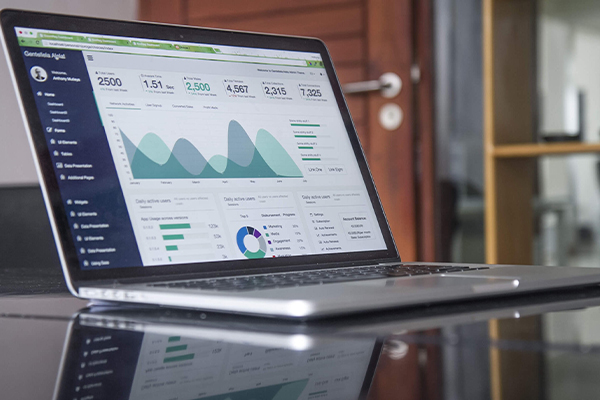Descriptive Statistics
Out of the entire traffic, Facebook contributed 7.4 percent of it wile Google redirects covered the rest (see figure 1). 8.5 percent of the keyword target was specific, 20.1 percent was general while 71.4 percent of it had none of the targeted keywords. The average page page views were 4 per visit. The sessions summed up to 503,506 minutes (mean= 240.22 minutes). The period yielded 40 conversions that amounted to $ 4272 dollars, averaging $2.04 per transaction.
Figure 1 Count of Source
Correlation Analysis
A correlation of the variables that are assumed to influence conversions and amount spent was done. The session duration and page views all have a slight positive correlation to the dependable variables of conversions and transaction amount. The correlation of session duration to conversions was 0.0390 while to transaction amount it was 0.0479. The correlation of page views to conversion was 0.0420 while to the transaction amount it had a correlation coefficient relative to the transaction amount was 0.04341.
Market Analytics
The Cost per mile (CPM) for Google with a General Keyword is $1620. The click through rate is 28.13 percent. The conversion rate for this particular package of advertising was 0.27%. The effective cost per mile for the Google Ads campaign with General keyword was $162.67.
The CPM for Google with Specific Keyword is $470. The click-through rate is 21,43 percent. The conversion rate for this ad package is 6.06 percent. The effective cost per mile of the Google with Specific Keyword Campaign was $2545.45.
The Facebook campaign has a CPM of $450. The click-through rate was 4.00 percent. The conversion rate was 0.98 percent. The effective cost per mile of the Facebook ad campaign was $870.42.
Organic Google searches yielded 6674 impressions on the company website, resulted in 24 conversions worth $2532. The conversion rate of these organic searches was 849.66 percent. The effective cost per mile here was $379.38.
The overall bounce rate of the campaign was 23.09.
Discussion
The potential of Google’s search engine makes it the primary driver of traffic to the company website. The effective cost per mile of Google campaigns with specific keywords was irrationally high considering the conversion rate from organic searches is 849.66 percent relative to 6.06 percent in specific keywords search in Google. After all, 71.4 percent of searches had no relation to the keywords, general or specific, that the company paid for in its campaign.
The campaign yielded insignificant conversion rates, and only the organic searches translated to conversions worth noting. Of all the campaigns, the general keyword Google Ad campaign had the lowest effective cost per mile. However, this cost-sparing nature did not come with cost-effectiveness, and the opportunity cost of running a campaign does not seem justified in the financial sense.
Besides, these underwhelming metrics from the market analytics second the correlation analysis that showed slight positive correlations between redirection to the site and page visits to conversions and amounts spent. The company seems to be on autonomous marketing run through which its reputation and consumer loyalty is perpetuated through other media aside from online.
Implications
These finding imply that the online ad campaigns are all but cost-effective. The promotion of the company’s ranking in search results and social media has done little to increase its sales. The prevailing consumer awareness seems robust enough to generate traffic to the website. Alternatively, the company’s consumers may have low sensitivity to advertisement and public relations campaigns in the formulation of their purchase decisions. The marketing must not have done sufficient market research before investing in the marketing strategy that yielded underwhelming results.
Moreover, the management of ecommerce sites has been optimized through other empirical methods that do not involve marketing campaigns. The concern is the consumer satisfaction in product quality and delivery systems. Such intangible setups of retail stores transfer a significant amount of risk to the consumers compelling them to deny marketing campaigns at face value, consumer feedback drives their loyalty to ecommerce retailers. This makes the high conversion rate of organic searches more fruitful as consumers direct their preference absent of the promotional interventions of the company.
Crucial Data for Future Campaign Analysis
The availability of various metrics tools that Google and Facebook promotions provide were absent of crucial information on the role of the consumer’s referrals, consumer feedback and quality control assurance. Besides, the framework of the campaign and its emphasis were lacking in the discussion of the various campaigns. The strengths highlighted, diction used, market filters and reach of the campaigns were not included in the collected data. These omissions made the analysis rigid and its findings wanting in various aspects.
The inclusion of the parameters discussed herein should portray a wholesome picture of the relationship of the company with its customers and the potential areas for improvement. Besides, the company has a need to optimize its marketing budget that requires consideration of all the cost-effective alternatives that ecommerce offers for marketing and promotion (Visser, Sikkenga & Berry, 2018).
Recommendations
This marketing campaign would be overhauled due to its apparent ineffectiveness in increasing conversions. The promotion of a proper logistic framework should follow to foster consumer confidence, and thus build loyalty to their products. Numerous options such as omni-channel retail stores, same-day delivery and promotion of positive consumer feedback should direct traffic from their competitors to their website (Piotrowicz & Cuthbertson, 2014). The use of contemporary best practices in ecommerce are advertisement enough to maintain a company’s market share. This explains why their company has more conversion and sales volumes from organic searches from persons that deliberately search for it.
Besides, the company website should be tweaked to improve the user experience such that the bounce rate is decimated further. The use friendliness of the website is its f

